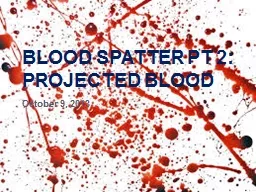

October 14 2014 Points of origin and convergence The source of blood spatter can be localized by following the direction of travel of several stains Direction of trave l The narrow end of an elongated ID: 707288
Download Presentation The PPT/PDF document "Blood Spatter Pt 2: Projected Blood" is the property of its rightful owner. Permission is granted to download and print the materials on this web site for personal, non-commercial use only, and to display it on your personal computer provided you do not modify the materials and that you retain all copyright notices contained in the materials. By downloading content from our website, you accept the terms of this agreement.
Slide1
Blood Spatter
Pt 2:Projected Blood
October
14, 2014Slide2
Points of origin and convergenceThe source of blood spatter can be localized by following the direction of travel of several stains.Direction of travel
The narrow end of an elongated blood stain usually points in the direction of travelSlide3
Points of origin and convergenceThe source of blood spatter can be localized by following the direction of travel of several stains.Point of convergence
By using string to back-track the trajectory of blood stains in 2-Dspace, you can find the point of
convergenceSlide4
Points of origin and convergenceThe source of blood spatter can be localized by following the direction of travel of several stains.Point of origin
By using string to back-track the trajectory of blood stains in 3-Dspace, you can find the point of originSlide5
Points of origin and convergenceWhat is the difference between the point of origin and point of convergence?Point of origin is in 3D space, point of convergence is in 2D space.
How can you determinethe height from whichthe blood fell?Find the angle of
i
mpact using
s
in
-1
(width/height)Slide6
Classifying SpatterWe already classified spatter as passive or projected.
What is the difference between these?Passive – no force applied to blood other than gravity. Example: blood dripping from a knife
Projected – force is applied to the blood
Example: blood spatter from gunshot wound
Spatter can also be classified by velocity or by mechanism of projection.Slide7
Classifying Spatter by VelocitySpatter can be classified by the velocity of the projecting force (not velocity of the blood itself).
Low Velocity Impact Spatter (LVIS) – When source of blood is subjected to a force with a velocity of up to 5 feet per second. Primary stains are usually 4 mm in diameter or greater.
Example: This spatter often occurs
after
an injury, Slide8
Classifying Spatter by VelocityMedium Velocity Impact Spatter (MVIS) – When source of blood is subjected to a force with a velocity of 5 to 25 feet per second. Most stains will range from 1-3 mm in size.
High Velocity Impact Spatter (HVIS) - When source of blood is subjected to a force with a velocity of 30 feet per second or more. Most stains will be smaller than 1 mm in size.
Example:
gunshot wound
Example:
beating with fists or blunt objectsSlide9
Classifying Spatter by VelocityHow does the velocity of the impact object affect blood spatter?The higher the velocity of impact, the smaller the size of the spatter.
Are these the same patterns you would expect if the blood was traveling at these speeds? Why or why not?No, the patterns are opposite. When the blood itself travels at higher velocity, the spatter is larger.Slide10
Classifying Spatter by MechanismBack spatter / blow back – blood that comes out an entrance wound; often lands on the weapon and/or perpetratorForward spatter –
blood associated with an exit woundSlide11
Classifying Spatter by MechanismExpirated blood – blood that is blown out of the nose, mouth, or wound as a result of air flow
Cast-off pattern – blood stains pattern created when blood is released from a moving, bloody object (e.g. a bloody knife swung through the air)
Often small, diluted with saliva, and may have bubbles
Often large drops in a linear or arcing patternSlide12
Classifying Spatter by Mechanismarterial bloodstain pattern – bloodstains resulting from blood projected out of a damaged artery
transfer pattern – a bloodstain created when a bloody object touches another surfaceOften form a large spurting patternSlide13
Classifying Spatter by MechanismWipe pattern – blood stain created when an object moves through an existing stain
Swipe pattern– the transfer of blood from a moving source onto an unstained surfaceExample: The murder pulls the body across the blood-stained floor
Example: the murder touches the unstained wall with bloody hands as he walks away
Feathered edge shows direction of travelSlide14
Classifying Spatter by MechanismVoid pattern – Areas that are absent of blood stains in an area that is otherwise full of blood stains
Example: Can occur if a bloody item was removed from the sceneSlide15
You DoCreate
2 vocabulary posters with assigned words.Poster should haveThe word in large lettersThe definition in your own words
A colorful picture that illustrates the word
Blood quiz next class
!Slide16
ClosureWhat were our objectives today? How did we meet them?What was our learner profile trait and how did we use it?
How does what we did today address our unit objective?Slide17
Exit TicketHow does the velocity of impact change the characteristics of the spatter?
Differentiate between forward spatter and back spatter